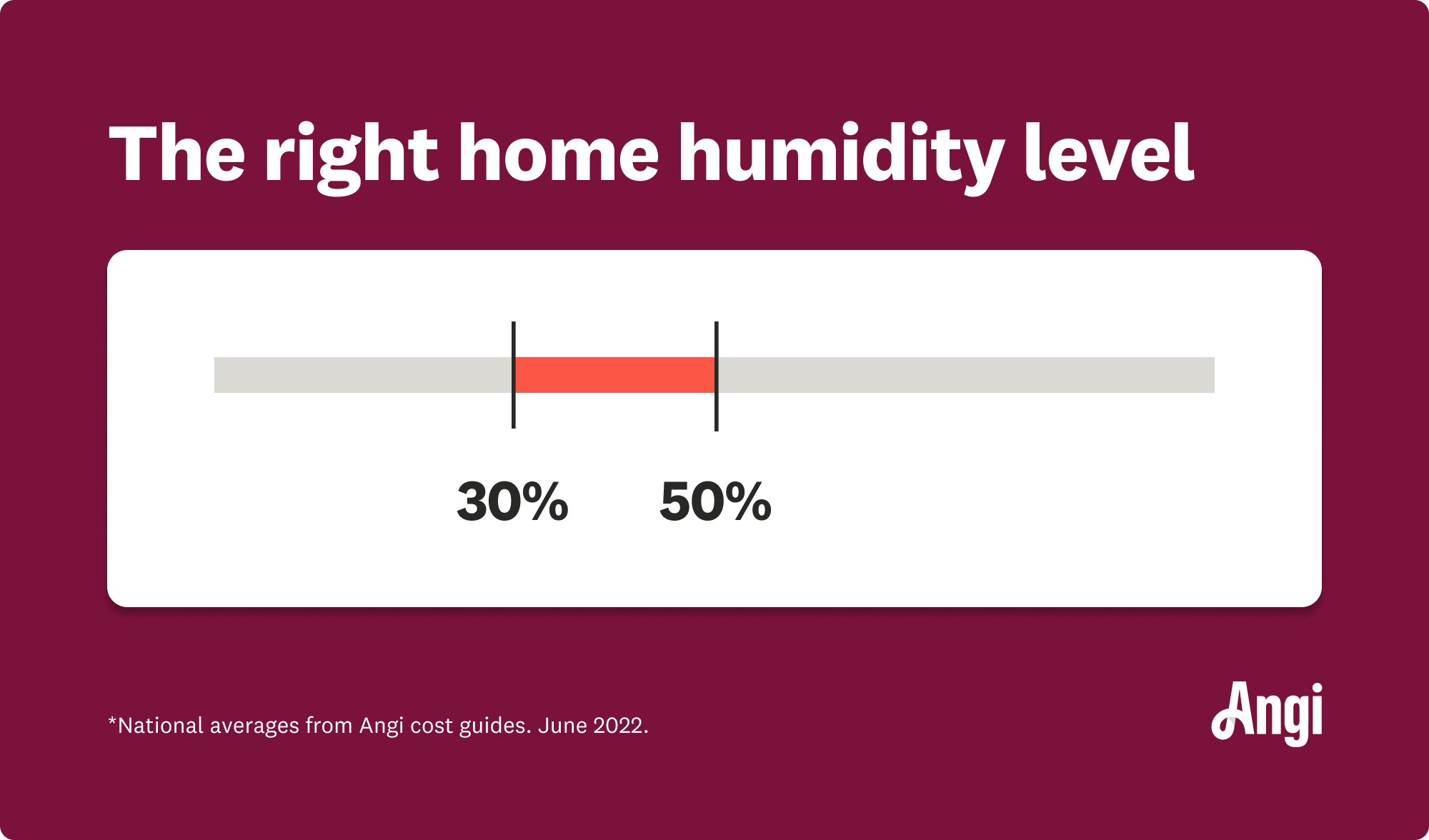The Ideal Indoor Humidity Level for Your Home
The right humidity setting could be the difference between dry skin or a mildew infestation


The ideal home humidity level is between 30% and 50%.
You can measure your home humidity level with a hygrostat.
Appropriate humidity levels can mean better health, more energy savings, and preserving the wood in your home.
Consider investing in a whole-home humidifier, which costs between $100 and $300.
During the winter, your furnace humidifier fights against dry air to keep your home balanced. But it also works quietly behind the scenes during the summer when you have the air conditioner cranked. This is a good thing. For maximum comfort, your furnace dehumidifier should run year-round to maintain an ideal “summer” humidity setting. Here’s what you need to know.
What Is Humidity?
While you may not actively think about it, water vapor floats around in the air in your home. This water vapor is measured in percentages and indicates how much water the air can hold before the water changes to liquid form, causing condensation. Controlling humidity in your home is important because while you want the benefits of having moisture in the air, having too much leads to problems like mold and mildew.
The Ideal Home Humidity Range

You’ll want to aim for 30% to 50% humidity in your home for the maximum comfort level. There are a couple of things you have to factor in when setting your home’s levels during the summer.
Indoor humidity is inevitable in humid climates, so you’ll need to adjust your settings.
Running your AC unit will dry out the air in your home.
Keeping the humidity levels in the right range is a balancing act, but it’s a good idea to start at 40% and make adjustments based on whether you have too much moisture in the air or not enough. Using this setting along with other summer HVAC tips should keep the air in your home comfortable.
Ideal Indoor Humidity Relative to Outdoor Temperature
The reason why indoor humidity is a range is because it needs to fluctuate based on the temperature outside. Cold air holds more moisture, so if the air inside is warmer than the air outside and that cold air enters your home, condensation can form.
If you live in a region prone to high humidity, like the South, then you’ll need to set your indoor humidity to the higher end of that range. Here are some helpful guidelines:
| Outdoor Temperature (in degrees Fahrenheit) | Max Indoor Humidity (in Percent) |
|---|---|
| 20 – 40 | 40 |
| 10 – 20 | 35 |
| 0 – 10 | 30 |
| -10 – 0 | 25 |
| -20 – -10 | 20 |
| -20 – lower | 15 |
Why Regulate Humidity?
There are numerous benefits that you can get from keeping your home humidity at an appropriate level.
Better Health
Keeping your home’s humidity around 40% provides health benefits to you and your family. Humidity keeps your nasal passages and throat moist, preventing dry, irritated sinuses that can spark illness. You’ll also keep itchy eyes and dry skin at bay by keeping your humidity levels up.
Prevents Wear and Tear on Your Home
If your humidity setting is too high, you’ll create a damp environment where mold and mildew thrive. Set it too low, and your wood and furniture can dry out and crack. Are you working on building a dreamy home library? Low humidity levels also make it difficult to keep books in good condition, leading to cracking spines and dried glue.
Helps Save Energy
The right amount of moisture in the air will make your home feel cooler, allowing you to set your air conditioner at a higher temperature. Increasing the thermostat even one or two degrees during the summer can make a difference in your energy bill.
How Do You Measure Humidity?

You can measure humidity levels in your home with a hygrometer device or an indoor humidity monitor. Most local hardware stores sell them, and the basic models usually cost around $15 to $25.
Aside from springing for a hygrometer, watch for signs that indicate your humidity levels are off. If moisture forms on the inside of your windows, your humidity level is probably too high. If your plants (and your skin) are drying out, or you experience a shock when you touch a light switch, your levels are likely too low.
How to Regulate Humidity in Your Home
One of the best ways to control moisture and humidity in your home is to invest in effective humidifiers for the summer (or dehumidifiers for the winter). These portable small appliances cost anywhere between $50 to $400 or more, depending on how much of an area you need to cover.
Depending on the size of your home, you may only need a couple of these to cover the most important rooms. But if you live in extremely humid climates (think: Florida, Louisiana, or Hawaii), it may be more cost-effective to invest in a whole-house humidifier. Another scenario is if you have a finished basement that lacks any kind of climate control.
You can hire an HVAC technician to install a whole-house humidifier. A whole-house humidifier costs around $600.





- Furnace Repair
- Air Conditioning Repair
- HVAC Repairs
- Furnace Installation
- Wood & Pellet Stove Repair
- Dehumidifier & Humidifier Repair
- Heat Pump Companies
- Swamp Cooler Repair
- Wood Stove Services
- HVAC Companies
- Commercial A/C Repair
- Geothermal Installation
- Air Conditioning Installation
- Boiler Repair
- 24 Hour Furnace Repair
- Geothermal Repair
- Heat Pump Repair
- Humidifier Installation
- Thermostat Repair
- Thermostat Installation
- Nest Installation
- Heating & Cooling
- Heating Repair
- Furnace Cleaning
- Furnace Tune-Up
- HVAC Technicians
- Subcontractors
- Furnace Maintenance
- Plumbing & Heating Companies
- Wood Stove Inspection
- Mini Split Installation
- Wall Heater Repair
- Duct Installers
- How to Measure Humidity in Your Home With and Without a Hygrometer
- What Should the Humidity Be in a Basement?
- What Is the Best Temperature to Set Your Air Conditioner to in the Summer?
- Breathe Easy: 10 Tips for Improving Your Indoor Air Quality
- 7 Things to Consider When Choosing a Basement Dehumidifier
- Condensation on Ductwork: Causes and Potential Solutions
- How to Tell If the Return Air Is Working With These Simple Tips
- What Is the Best Time of Year to Remodel Your Home?
- Why Some Rooms Are Colder Than Others and How to Fix It
- How to Stop Condensation on Air Vents to Prevent Mold and Mildew Growth










